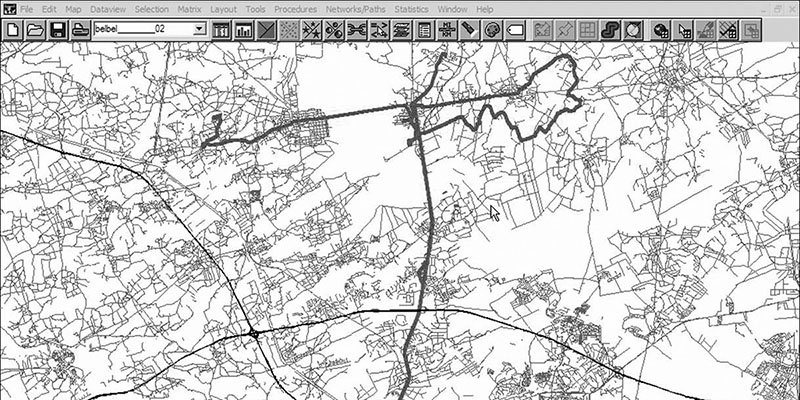Downloads
DOI:
https://doi.org/10.7480/rius.1.202Abstract
This chapter addresses two issues related to tracking people through mobile technologies and spatial planning decisions. The first major part deals with the question of how knowledge developed through the use of new tracking technologies can impact the spatial planning process. We argue that global positioning system (GPS) data are valuable – if not vital – for the improvement of travel demand forecasts by means of an activity-based transportation model when assessing travel demand management (TDM) policies such as spatial planning strategies.
Based on a brief historical outline with regard to planning policies and an overview of various travel demand models, the need for advanced data and their use in modelling practice is shown. In the next section, the other topic of this chapter discusses what kind of spatial interventions can be expected due to the use of new tracking technologies. Here, four application areas related to travel demand modelling are identified and subsequently explained: the use of route knowledge and the concepts of accessibility, activity spaces and mental maps.
How to Cite
Published
Issue
Section
License
Copyright (c) 2008 Davy Janssens, Els Hannes, Geert Wets

This work is licensed under a Creative Commons Attribution 4.0 International License.
References
Arentze, T.A., & Timmermans, H.J.P. (2000) Albatross: A learning-based transportation oriented simulation system, European institute of retailing and services studies, Eindhoven.
Banister, D. (2000) Sustainable urban development and transport – a Eurovision for 2020. Transport Review, 20(1), pp. 113- 130.
Battelle (1997) Lexington travel survey, Batelle.
Chen, C. and Wei, L. (2006) The evolution of accessibility over time. In: IABTR (International Association for Travel Behaviour Research), 11th International Conference on Travel Behaviour Research. Kyoto, Japan 16-20 august 2006.
Dijst, M. (1997) Spatial policy and passenger transportation, Netherlands Journal of Housing and the Built Environment, 12, pp. 91-111.
Hannes, E., Janssens, D. and Wets, G., (in press) Does space matter? Travel mode scripts in daily activity travel, environment and behavior (accepted for publication september 2007).
Hines, P., Marsay, A., Edge, J. and Gal, k., (2002) Transport Development Areas: guide to good practice, RICS, London.
Janssens, D. and Wets, G. (2005) The presentation of an activity-based approach for surveying and modelling travel behaviour, proceedings of the 32nd Colloquium Vervoersplanologisch Speurwerk 2005: Duurzame mobiliteit: ‘hot or not?’, Edition 32, part 7, Antwerp, Belgium, pp. 1935-1954.
Kim, H. and Kwan, M. (2003) Space-time accessibility measures: a geocomputational algorithm with a focus on the feasible opportunity set and possible activity duration, Journal of Geographical Systems, 5(1), pp. 71-91.
Kitamura, R. & Fujii, S. (1998) Two computational process models of activity-travel behaviour. In: T. Gärling, T. Laitila and K. Westin, eds, Theoretical Foundations of Travel Choice Modelling, Pergamon, Oxford, pp. 251-279.
Kochan, B., Janssens, D., Bellemans, T. and Wets, G. (2005) Collecting activity-travel diary data by means of a hand-held computer-assisted data collection tool. in: EWTG (Euro Working Group on Transportation), 10th EWTG Meeting/16th mini EURO conference, Poznan, Poland, 13-16 September 2005.
Krygsman, S. (2004) Activity and travel choice in multimodal public transport systems, PhD thesis, Utrecht University.
Mc Gowen, P.T. (2006) Predicting activity types from GPS and GIS data, University of California, Irvine.
Meadows, D.H., Meadows, D.L., Randers, J. and Behrens III, W.W. (1972) The limits to growth: a report for the Club of Rome’s project on the predicament of mankind, Universe, New York.
Morency, C.P. and Kestens, Y. (2006) Measuring activity spaces of people, households and population segments. in: IATBR (International Association for Travel Behaviour Research), 11th International Conference on Travel Behaviour Research. Kyoto, Japan 16-20 August 2006.
Resource Systems Group, Inc. (1999) Computer-based intelligent travel survey system, Research Systems Group, White River Junction (VT).
Ruiter, E.rR and Ben-Akiva, M.E. (1978) Disaggregate travel demand models for the san Francisco bay area, Transportation Research Record, 673, pp. 121-128.
Schönfelder, S. and Axhausen, K.W. (2003) On the variability of human activity spaces, arbeitsbericht Verkehrs- und Raumplanung, 149, Institut für Verkehrsplanung und Transportsysteme (iVT), ETH Zürich, Zürich.
Taylor, N. (1998) Urban planning theory since 1945, Sage Publications, London.
Townshend, T. (2006) From inner city to inner suburb? Addressing housing aspirations in low demand areas in Newcastle Gateshead, UK, Housing Studies, 21(4), pp. 501-521.
Victoria Policy Institute (2007) TDM Encyclopedia. http://www.vtpi.org/tdm/index.php, accessed November 22, 2007.
World Commission on Environment and Development (1987) Our common future (Brundtland report), Oxford University Press, Oxford.
Zhou, J. (2004) Real-time tracking of activity scheduling/schedule execution within unified data collection framework. In: TRB (Transportation Research Board), 83th Annual meeting of the Transportation Research Board, USA, Washington, 11-15 January 2004.
Zuallaert, J. (1998) Het mobiliteitsplan - Fase 2: opbouw van het plan. In: Het mobiliteitshandboek - Afl. 5, Ministerie van de Vlaamse Gemeenschap, pp. 73-88.




